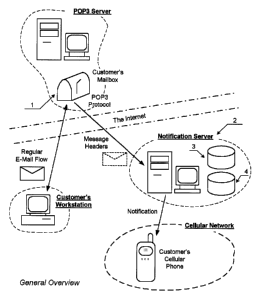Note : Les descriptions sont présentées dans la langue officielle dans laquelle elles ont été soumises.
From to 1-819-953-2476 at 3/24/00 2;36 ~t Pg 003/008
DESCRIPTION
BACKGROUND
This invention relates to a process of producing notifications to wireless
device users about
arriving new e-mail messages to their Internet mailbox accounts.
The well-known "e-mail" feature in the Internet is usually based on the
service of electronic
mailboxes provided by various organizations and accessible around the globe by
means of the
standard protocol called Post Office Protocol - Version 3 (POP3), described in
Request for
Comments 1725 (RFC 1725), Network Working Group, November 1994. From time to
time,
users connect to their mailbox providers, log on to their mailboxes and
download new messages
from it. Until user logs on to the mailbox, there is no any indication on his
local site about new
mail presence.
DESCRIPTION OF PRIOR ART
At the present time, there are two common ways how Cellular Service Provider
(CSP)
companies obtain new e-mail notification information to their subscribers:
1. Request the subscriber to change his/her Internet e-mail address to CSP's
POP3 server
address. When a new message arrives to their server, CSP generates a new e-
mail notification at
that server, sends this notification to the subscriber's cellular phone and
then forwards the
original message to the subscriber's server or let the subscriber to pick up
messages from the
CSP server.
The disadvantage of this approach is that each subscriber has to request all
his correspondents to
change his address to the CSP's one.
For example, this method is implemented at Cantel AT&T Wireless and FIDO CSPs
cellular
companies.
2. Request the subscriber to forward inbound e-mail messages from his local
workstation to CSP
SMTP server. The CSP generates a notification message at his SMTP server and
sends it to the
client's cellular phone or pager.
The disadvantage of this method is that each subscriber requires to have a
running computer and
a permanent IP connection.
For example, this method is used at Bell Mobility. cellular company
CA 02302801 2000-03-23
From to 1-819-953-2476 at 3/24/00 2:36 PM Pg 004/008
Some interesting ideas how to produce notification about new e-mail arriving
using wireless
devices like cellular phones are also described in Canadian Patents number
2254803, 2223337,
2251589.
CA 02302801 2000-03-23
From to 1-819-953-2476 at 3/24/00 2:36 PM Pg 005/008
SUMMARY
These disadvantages may be overcome by introducing a special type of central
mailbox scanning
server at the CSP site (Fig.l).
To provide the notification service, the CSP runs a special server program
that will periodically
log on to the subscriber's POP3 mailbox over the Internet using account
information and
password provided by the subscriber, download available messages, generate
notifications for
the new ones and then leave the subscriber's mailbox without removing any
messages from it
(Fig.2).
Because subscriber's mailbox remains intact, this method of obtaining
notification information
and forwarding it to the wireless device will have minimal overhead to the
customer. To receive
notifications the subscriber will not be required to have a running computer
or special software
and his e-mail addresses will remain the same.
DETAILED DESCRIPTION
To obtain message notification information, CSP introduces a Notification
Server (NS) (Fig. 1
pos. 2) that has an access to the Internet.
The NS works as a POP3 scanning client against subscribers' POP3 mailbox
accounts (Fig. 1
pos. 1). NS has its own database (Fig. 1 pos. 3) comprising the subscribers'
accou~ information
comprising POP3 server address, user name and password. NS logs on to the
subscribers'
mailboxes on a periodical basis, downloads available messages from said
accounts and then logs
off without removing messages from the mailboxes (Fig. 2). Hence, the
subscriber's regular e-
mail flow will not be affected by the notification service.
Notification Server stores (Fig. 2 pos. 5) message identification information
in its local database
(Fig. l pos. 4) for forwarded notifications, so next time it logs on to that
mailbox it will not send
the duplicated notification to the subscriber if the notified message is still
there (Fig. 2 pos. 6).
The Notification Server removes message identifications from its local
database for messages
that are not present in the mailbox (Fig. 2 pos. 7). That are messages have
been downloaded by
the subscriber during his regular mail checkup.
CA 02302801 2000-03-23
